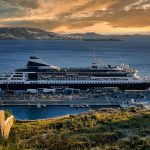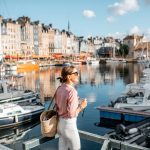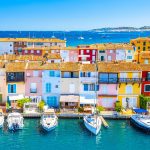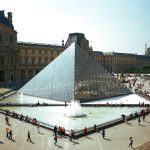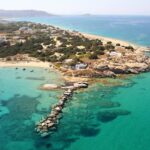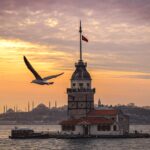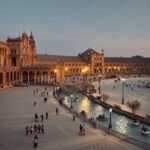Crete Travel Guide 2024
Introduction
Crete Travel Guide – Crete is a great island to visit at any time of year. The southernmost Greek isle has beaches, ancient archaeological sites, throwback villages, and myriad nature hikes—not to mention the pleasant winter temperatures. Spreading its rows of olive trees along the hills and diffusing the scent of laurel and bougainvillea in the villages, Crete is a resolutely Mediterranean island. Located about 200 kilometers from the Cyclades, Greece, two weeks would hardly be enough to visit this cradle of Minoan civilization: golden beaches, crystal-clear waters, constant warmth, tasty Greek gastronomy, picturesque villages and places steeped in history. Take the time to visit its palaces and ancient ruins, such as the famous palace of Knossos (Knossos) a few kilometers from Heraklion or the palace of Malia. This tourist guide will help you piece together the puzzle of European history, of which Crete holds many memories and treasures. Crete has preserved its authenticity and natural wonders such as the beaches of Elafonissi or Gramvoussa in the south of a chimeric blue. Life here is peaceful and the fishermen take pleasure in sharing precious moments with travelers, regardless of language differences. The day is marked by the inevitable siesta that follows lunch and freddo coffee, to let the hottest hours pass by. In the evening, locals and tourists meet on the terraces of the restaurants, enjoying the sweetness of the night, good local wine and fresh fish. This is an opportunity to test the saligaria, the Cretan snail and the raki that breaks down inhibitions. The villagers sometimes sing Cretan folk songs, accompanied by steps of pendozali, the traditional dance. Forget the looks and let yourself be caught up in the game. Spending holidays in Crete is an opportunity to discover its specialties. Far from the hustle and bustle of the big cities, you will be charmed by its small traditional villages with their feet in the water. Crete seems blessed by the gods and this, since mythology.
Recommended Vacation Packages to Crete
- Athens – Mykonos – Santorini – Crete
- Best of Turkey and Greece with 2-day cruise
- The Great Odyssey
- Mainland Greece and Islands
- Classical Greece and Turkey with 3 Days cruise
- Best of Crete
- Crete Explorer
- Best of Greece and Turkey with 3-day Cruise
Getting There
Crete has two main airports, Chania (CHQ) and Heraklion (HER), and the majority of travelers fly into one of the other with a stop in Athens. Travelers from North America can typically expect a stopover in a European hub on the way to Athens, as well. Chania, on the west side of the island, is convenient to the White Mountains, Elafonisi, and Balos Beach. Heraklion is equidistant to major sites and close to Knossos and the archeological museum. Ferries from Piraeus on the mainland are also available, best utilized in the summer when the service schedule is most robust. Crete’s ports with ferry service include Chania, Iraklio, Kissamos in western Crete, and Sita to the east. Timetables and fares change frequently throughout the year.
When to Go
Because Crete is the southernmost Greek island, temperatures remain pleasant throughout the year—this is where you want to be if you’re visiting Europe in winter months, with average temps hovering in the 60s (Fahrenheit). This is perfect hiking weather, many sites of interest will be uncrowded, and seasonal activities starting in November include olive, herb, and orange harvesting, followed by cooking classes and tastings. Summer is hot (though not as hot as the mainland—expect mid-80s) and very crowded, with long sunny days and ideal conditions for swimming in the Mediterranean. The shoulder seasons are both warm, and less crowded and pricey than summer—though you’ll find the water to be warmer in fall than in spring.
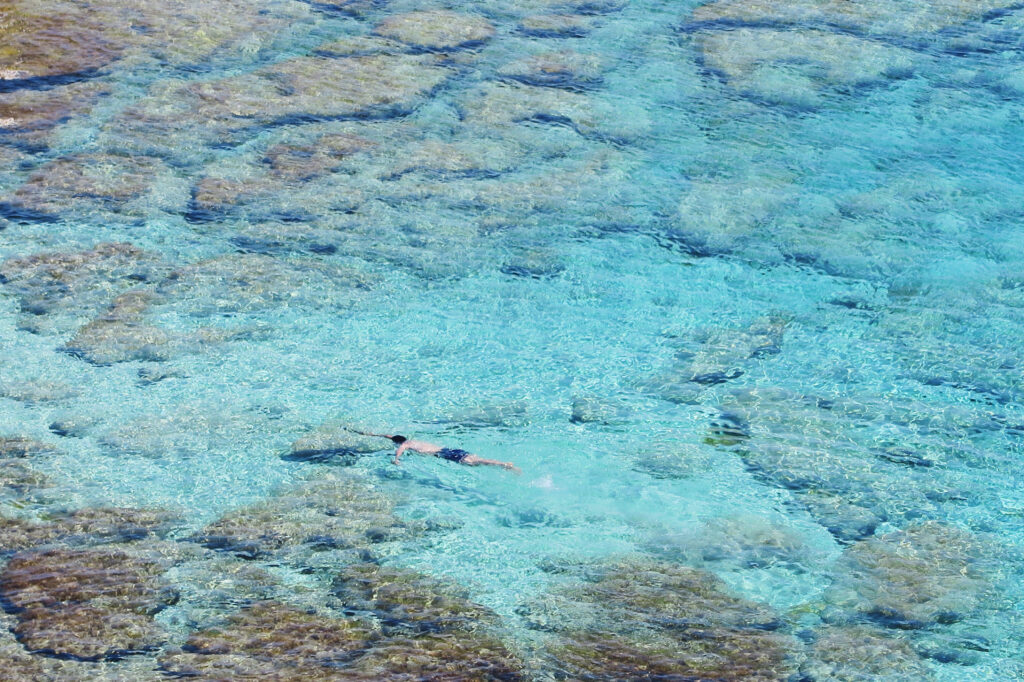
Brief History of Crete
Legends of Crete
The Crete history is long and marked by many historical periods. According to Greek mythology, the first queen of Crete was Europa. Later on, Crete island became the land of King Minos. The legend is that the king refused to sacrifice a bull to the gods and Poseidon punished him by making his wife fall in love with a bull. From this union, the Minotaur was born and was hid in a labyrinth. Another legend says that to avenge the death of his son by the Athenians, King Minos made them send seven young girls and boys to Crete every year, to offer them as a sacrifice to the Minotaur. During an expedition, the famous mythical hero Theseus, the son of the King of Athens, left Athens with the young Athenians and, with the help of Ariadne, the daughter of the King Minos, managed to kill the Minotaur and find his way out of the labyrinth.
Minoan Civilization
Ancient Crete is the place where the Minoan civilization, one of the most important civilizations of the world (2600-1150 BC), started. Huge palace-states were built, such as the famous and superb palaces of Knossos Palace, Phaestos Palace, and Zakros Palace, and the Minoans established a strong naval empire in the Mediterranean. This great civilization was stopped by a natural disaster: the huge waves caused by the eruption of the volcano of Santorini in 1450 BC covered the northern coasts of Crete with lava ashes. Followed by the invasion of the Achaeans and the Dorians, tribes from Northern Europe, the Minoan civilization never revived. The architecture of ancient sites and temples proves the wealth of the island since antiquity. The Roman occupation came in 69 AC and lasted until 330 AC, followed by the Byzantine era during which the wealth of Crete is still visible in the beautiful mosaic floor of the basilicas that were built during these times.
Venetian and Ottoman Periods
Crete later fell under the domination of the Arabs, in 824, and stayed under it for 137 years. During those years the city of Heraklion was founded, first called Handak. During the early Byzantine years, several churches and structures were constructed. In 1204, the Venetians founded newly fortified cities and conquered the island of Crete. They fortified the old castles built by the Arabs and built new castles. The old towns of Rethymno and Chania remain intact since the Renaissance, with their beautifully decorated squares, the superb fountains and its fine churches and palaces. During those years, the arts flourished such as painting and literature. The famous painter El Greco (Domenicos Theotocopoulos) started his carrier in this period and other artists and scholars from Constantinople came to Crete. In 1669, the island fell under the Ottoman rule which lasted until 1897, when the great statesman of Greece, Eleftherios Venizelos, negotiated the independence of Crete. Crete was declared an autonomous state and, in 1913, it was united with the independent Greek State. This period gave birth to one of the most talented writers of Greece, Nikos Kazantzakis (1883-1957). Many organizations were also founded for the education of people and schools and libraries were built.
Geography of Crete Island
Crete island is the largest and most mountainous of the Greek islands. It is located in the south part of the Aegean Sea and covers an area of 8,939 sq.km. The total population of Crete is 621,340 people. The island is characterized by its rocky spots and is surrounded by a beautiful mountain range including the White Mountains, Mount Psiloritis, and Dikty Mountain. Crete in Greece lies at the spot where the continents of Europe, Africa, and Asia meet and is divided into four regions: Chania, Rethymnon, Heraklion, and Lassithi. The mountains of Crete draw the attention whether you look from the west, east, north or south. The famous White Mountains have more than 52 peaks and Mount Psiloritis is the highest peak in Crete. In the east, the mountains of Dikty form a continuous chain from one end of Crete to the other. This creates impressive scenery which rises over the beautiful city of Sitia, in Lassithi. The mountains of Crete gifted the island with beautiful plateaus like Omalos. The sea currents have created impressive gorges, like the famous dramatic Gorge of Samaria and spectacular flourishing gardens with rare plant species that can not be found anywhere else in the world.
Heraklion
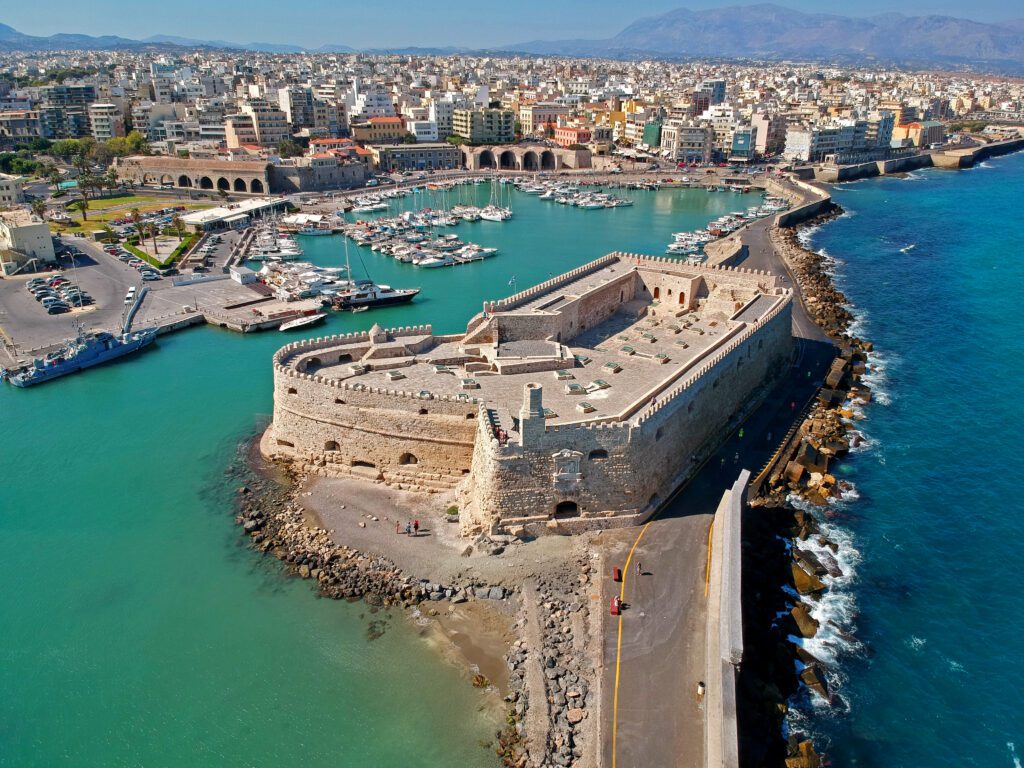
Heraklion Prefecture constitutes the central part of Crete and is situated east of Rethymno and west of Lasithi Prefecture. It is the largest urban town in Crete with a total population of 270,906 inhabitants. It is washed from the Cretan Sea (north) and the Libyan Sea (south). Farmlands are located in the central and the northern parts, at the coast and the valleys. Heraklion has been the birthplace of Minoan Civilization and generally, its history is interesting throughout all centuries.
Chania

Chania is a coastal town of Crete situated in the western part of the island. It is the second largest town of Crete, after Heraklion and one of the Minoan cities in ancient times. The history of Chania is very rich during Medieval Times, too. The region extends for 2376 square kilometers. It is bordered to the east with Rethymno prefecture while it is washed from the Mediterranean Sea, the Cretan Sea, and the Libyan Sea. The geography of Chania is gifted with imposing mountains and beautiful greenery, features that characterize the entire island of Crete.
Rethymno
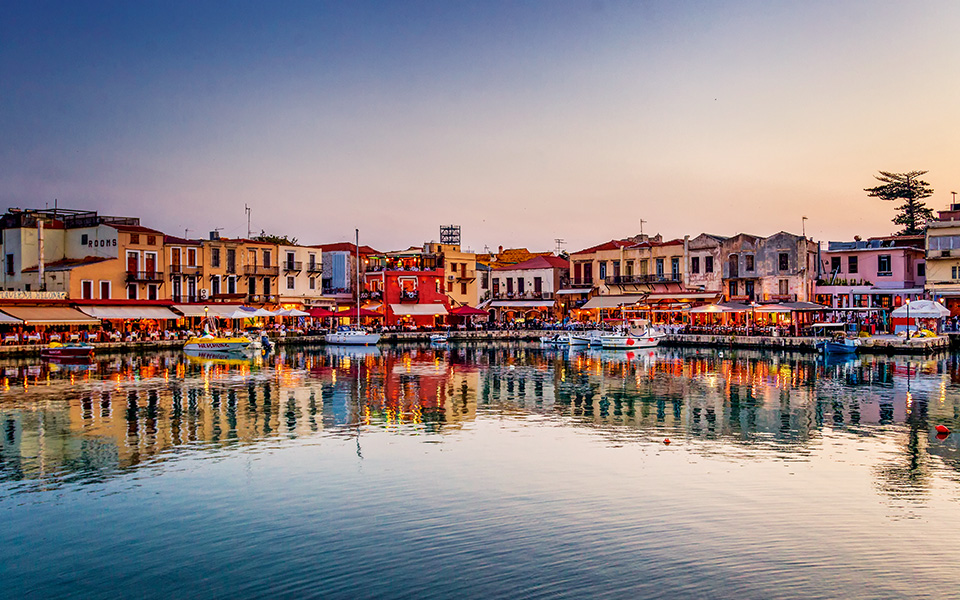
Rethymno is one of the four prefectures in Greece situated between the regions of Chania and Heraklion. It is washed by the Cretan Sea in the north and the Libyan Sea in the south. The central part of the capital of Rethymno is built on the cape and stretches along the beautiful long beach. A mountain range rises over the town, especially in the south, of which the highest peak is Mount Vrysina (858m). The terrain of Rethymno Crete is mainly mountainous and with interesting characteristics that very much resemble the other regions of Crete. A small part of the prefecture is flat, especially in the northern region. Rethymno has a restricted number of rivers, the most important being Geropotamos which extends from Mylopotamos to the sea and Megalos Potamos which flows into the lake of Preveli.
Lassithi
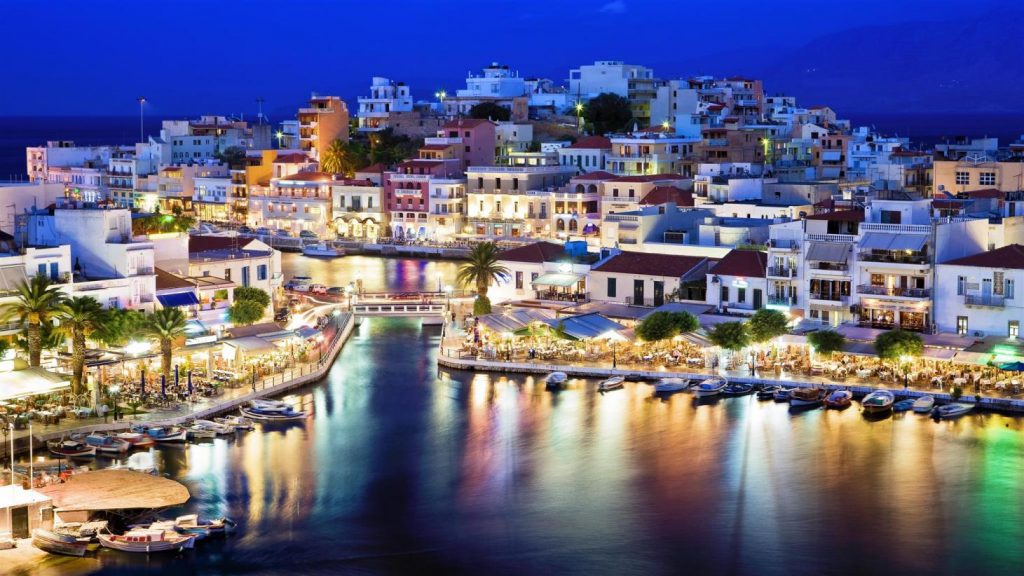
Lassithi Prefecture is situated in the easternmost part of Crete. In the other three parts it is washed by the sea: the Cretan Sea from the north, the Karpathian Sea from the east and the Libyan Sea from the south. On the east it borders with Heraklion prefecture and between them is the mountain range of Diktys. The capital of Lassithi is Agios Nikolaos. The terrain of Lassithi Crete is mainly mountainous, dominated by the mountains of Diktys, including the regions of Ierapetra and Mirampelos. Beautiful valleys with olive trees lay in these areas, close to the coasts. The coastline of Lassithi, Crete island, varies including a large bay (Mirambellos), a sea lake (Agios Nikolaos), sandy beaches, small and large ports in the north (Elounta, Sitia, Poros, and Faneromenis).
Crete Must See & Do
Crafting Your Crete Itinerary
The largest of the Greek isles, Crete is the birthplace of Zeus and the cradle of European civilization. It might also be the most distinct island of them all—nowhere else in Greece matches it for diverse landscapes. The highlights are well known, but there are plenty of hidden gems that most travelers miss. History buffs can choose from a long list of enlightening sites, like Knossos, the capital of the ancient Minoan civilization. If excursions are your thing, try hiking the trails in the White Mountains or lounging on the beaches of Elafonissi, with sands both white and rosy pink. The below list combines these gems with Crete’s other off-the-beaten-path spots and attractions.Though Crete fits nicely into a broader Greece itinerary, travelers often dedicate their entire trip to the country’s biggest island, spending a week or more exploring its beaches, mountains, and towns.

Interested in local experiences? Consider 1 to 5 days itineraries that dive into Cretan culture in Chania and Vamos—you’ll take a guided village-to-village trek, learn to prepare a meal with island-grown ingredients, stroll waterfronts and botanical gardens, and take in the views from ancient archeological sites at Knossos and Aptera. Crete also makes a great complement to a mainland tour, or a worthy stop on an island-hopping adventure.
Highlights of Crete Island
Balos Beach and Lagoon

At the northern tip of Crete, 35 miles northwest of Chania, lies Balos. This shallow turquoise lagoon is an icon unto itself—an ideal place to laze, snorkel, catch some rays, and soak up the isle’s beauty. The beach is actually a tombolo connecting tiny Tigani Island to Gramvousa Island. To arrive, you can drive from Chania, then hike 30 minutes downhill to the lagoon and beach. Or take a boat excursion (April-October), which combines Balos with a short visit to uninhabited Gramvousa, with its 16th-century Venetian castle perched commandingly atop the cliffs. Bring lunch and drinks with you, and double-check the boat departure times so you don’t get left behind at Balos or Gramvousa. Know that the beaches here can get crowded during peak seasons.
Walk through Chania

Crete’s second-largest and (some would say most evocative) city, Chania draws the lion’s share of summer visitors. The ancient Venetian harbor—lined with cafés, restaurants, and boutique hotels—is tourist heavy, but the atmosphere renders the crowds moot. It’s hard not to lose yourself in the images of local fisherman unloading sponges and octopus on the docks, or by wandering the mazes of narrow cobbled streets rising inland from the shore. Don’t miss Skridlof, a narrow lane and bazaar of leather products. Other arts and crafts stores are scattered throughout the walled old town. Most top sights can be seen strolling the harbor, which is separated into a western and eastern section and fronted by a pedestrian-only walkway. Start your stroll at the west entrance and you’ll see Fort Firca (aka the Revelino del Porto), which guarded the harbor in centuries past. Built by the Venetians to protect the harbor mouth, the fort’s bastion is home to the must-visit National Maritime Museum. It houses a superb collection of model ships, war relics, treasures, and other maritime items arranged in chronological order from the Bronze Age to WWII. A stone’s throw across the harbor, on the mole (outer wall) you’ll see the 16th-century “Egyptian Lighthouse.”
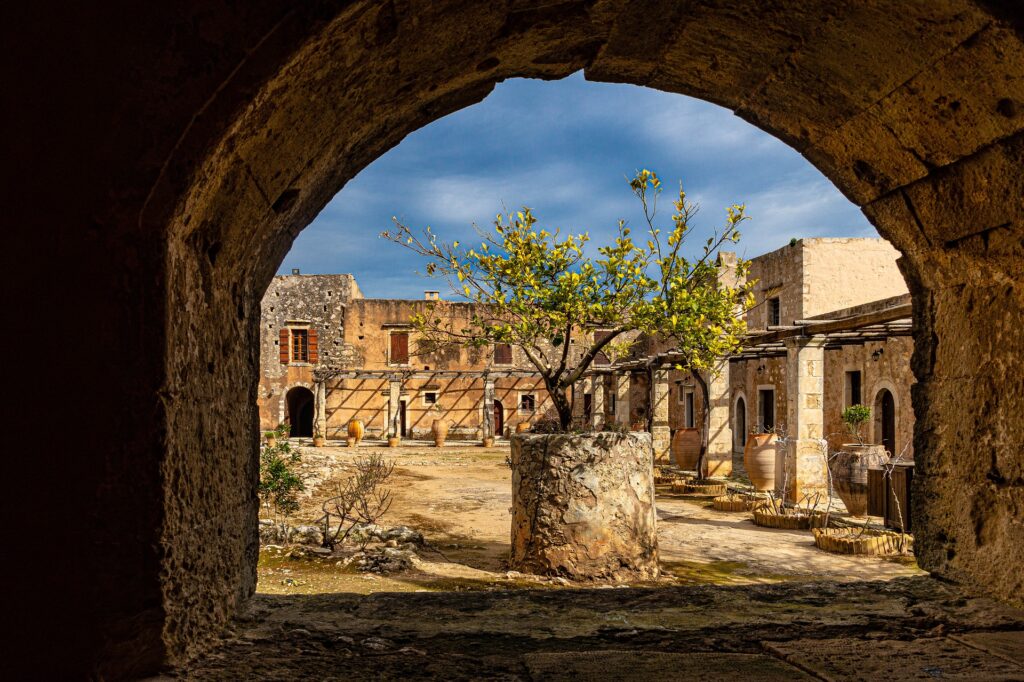
Following the western harbor as it curls like a shepherd’s crook, you’ll pass dozens of cafés, restaurants, and colorful town-homes. Notos Jazz & Bossa Café is a great place to stop for a coffee, cappuccino, or ouzo. Ahead, rising over the eastern side of the harbor is the domed 17th-century Mosque of the Janissaries. Built by the Turks during the Ottoman occupation of Crete, today it’s an art gallery. Continue eastward on the waterfront and you enter the second end of the harbor, lined with fishing boats and swanky yachts. The hulking Arsenali (Great Arsenal), built in Venetian times, has been restored and today houses the Center for Mediterranean Architecture—a cultural center with changing exhibitions and events. Now you’ll enter the old Turkish quarter of Splantzia, extending inland as a labyrinth leads you to St. Nicholas Square and the Agios Nikolaus (Church of St. Nicholas). Built as a monastery by the Venetians (hence the bell-tower), it was turned into a mosque by the Ottomans (hence the minaret). Don’t leave town without visiting the Agora—the cruciform Municipal Market—built atop the Venetian fortifications on Nikiforou Foka St. Here vendors sell olives, dates, bread, pickles, cheeses, and a kaleidoscope of fruits, veggies, and fresh-caught maritime critters.
Elafonissi
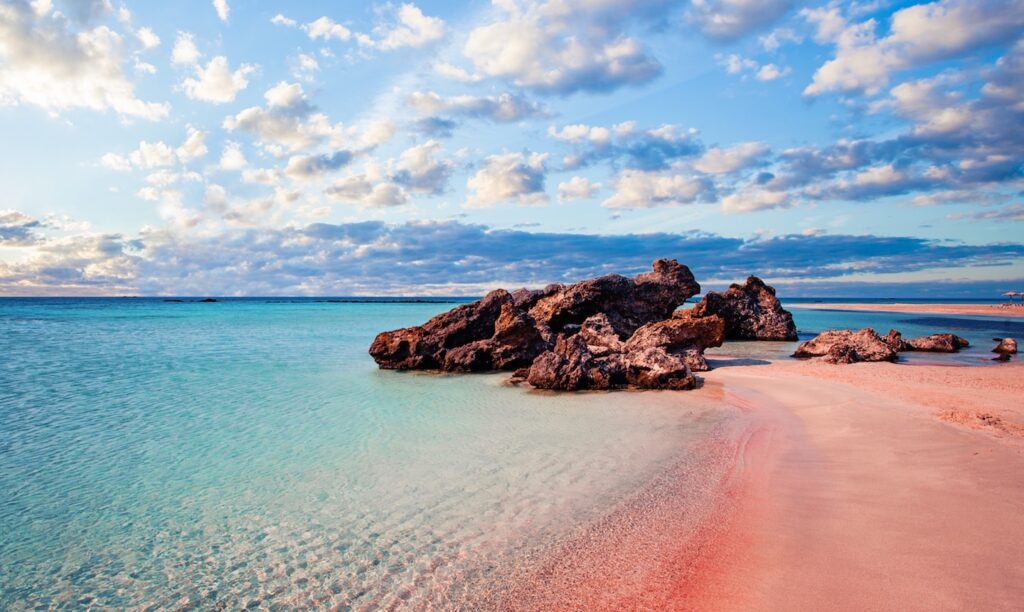
Just 45 miles southwest from Chania, Elafonissi is famous for its blush-pink sands running out to turquoise waters. It gets this pink hue from the numberless crushed seashells that adorn the beach. If you’re thinking of taking some as a souvenir, be warned: Elafonissi is a Natura 2000 Protection Program area and it’s illegal to remove the pink sand. To arrive here, you can drive from Chania (two hours) along windy and narrow roads, or book an excursion with a reputable tour agency. When you do arrive, you won’t be disappointed. Offshore, to the north, windsurfers zip across the water, while the south side is sheltered and good for snorkeling. Here you’ll find umbrellas, volleyball nets, bathrooms, and a trail leading to a chapel and lighthouse atop a tiny island connected to the mainland by a tombolo. In every season save for winter, you can expect to share this paradise with a legion of other travelers. By wandering away from the main beach, you can escape the throngs and find a secluded bit of sand in the tiny coves backed by juniper forest. Combine your visit to Elafonissi beach with a stop to the 17th-century Chrissoskalitissa Monastery, which is perched atop a cliff outside the village of Elafonissi. Built during the Venetian period, this Orthodox Christian nunnery draws a steady stream of visitors. You can ascend the 98 steps and inspect it up close, as well as visit the folklore museum on site. It actually takes its name from folklore: apparently, one of the steps is made of gold, but according to legend only true believers in God can see it.
Heraklion Archaeological Museum
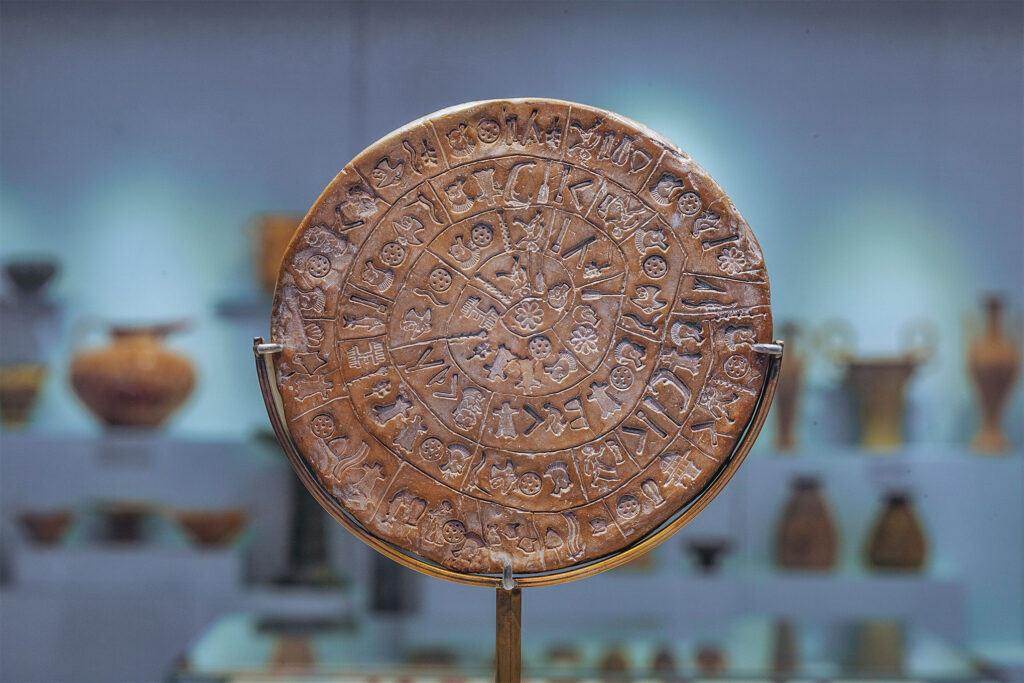
One of the most important museums in Greece, the state-of-the-art Heraklion Archaeological Museum offers an education in Crete’s ancient history that spans 5,000 years. The two-story venue, located in Heraklion in a rehabbed 1930s Bauhaus building, is a trove of archaeological artifacts displayed chronologically and thematically in color-coded rooms. Life-size statues, sarcophagi, Knossos’ famous frescoes, the enigmatic Phaestos Disk—you can see them all here. The mesmerizing displays (with descriptions in English) will keep history buffs enthralled for hours.
Knossos

To explore Crete and not visit the Palace of Knossos would be like visiting Paris without seeing the Eiffel Tower. The capital of the Minoan civilization (and first-ever city in Europe) is not only Crete’s most important historical attraction, but it’s also home to the mythical Minotaur of King Minos. Just three miles southeast of Heraklion, this former ceremonial and political hub boasted more than 1,200 rooms before it was destroyed around 1450 BCE by a natural calamity thought to have been a volcanic eruption of Santorini. Knossos was restored in the early 1900s by British archaeologist Sir Arthur Evans in a controversial effort to reconstruct certain palace features. You’ll need several hours to explore the evocative site, with its frescoes, massive columns, and a folklore-heavy museum that displays artifacts like vases. Knossos is best appreciated with an expert guide, as they can show you the hidden treasures (like the ancient plumbing and ventilation systems) and explain Knossos’ fascinating mythology. Arrive early to beat the heat and cruise-ship crowds.
Phaestos
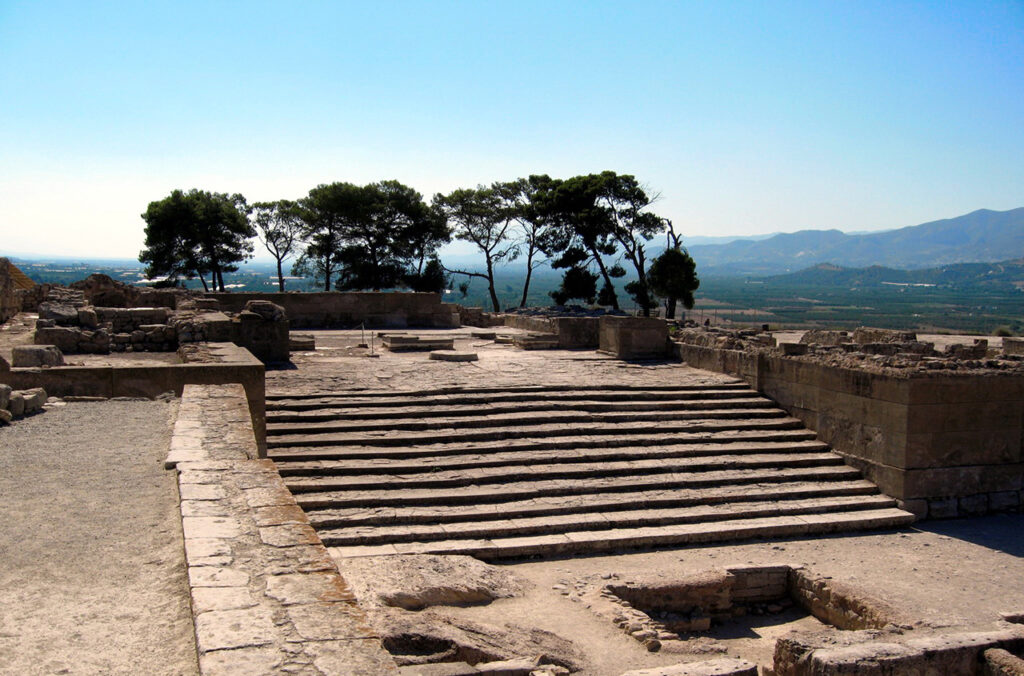
The ruins of Phaestos, a former Minoan palace, are a must-see, not least for its setting on a hill overlooking the verdant Massara Plain. As a tourist draw it’s second only to the more famous Palace of Knossos, and was similarly built around 1,700 BCE. It features a central courtyard that was once flanked by pillars, as well as the remains of temples, a theater, and royal apartments. Although simpler than Knossos and with fewer frescoes, it nonetheless exudes history. It was here, in 1908, that the mysterious Phaestos Disc was discovered. This Minoan disc of fired clay is imprinted on both sides with pictographs, still undeciphered, spiraling towards the center. You can find it today at the Heraklion.
White Mountains & Samaria Gorge
The entire west end of Crete is dominated by the White Mountains (Lefka Ori), a limestone massif towering up to 8,343 meters and topped with almost permanent snow. A wild landscape, deep gorges cut through the peaks and are home to many endemic species of flora and fauna—with luck you’ll spot a Cretan badger or endangered kri-kri, Crete’s native wild goat. The most famous gorge is Samaria (detailed below) but there are many more.
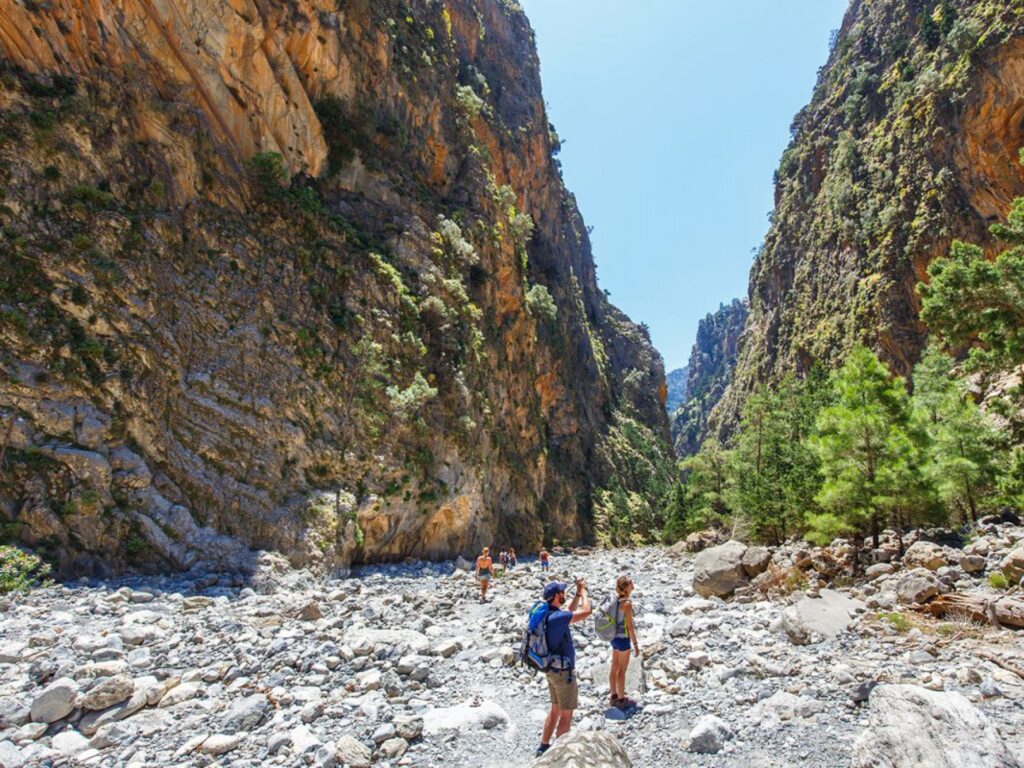
For many travelers, hiking the enigmatic Samaria Gorge—at 11 miles, the longest in Europe—is reason alone to visit Crete. Following a twisting path, the trail runs through the remote national park of Samaria and reaches its zenith when it narrows to just 10 feet wide, flanked on each side by rock walls rising 5,250 feet. Allow four to eight hours to cover the distance from Xyloskalo, perched high atop the Omalos plateau, to the seaside hamlet of Agia Roumeli.
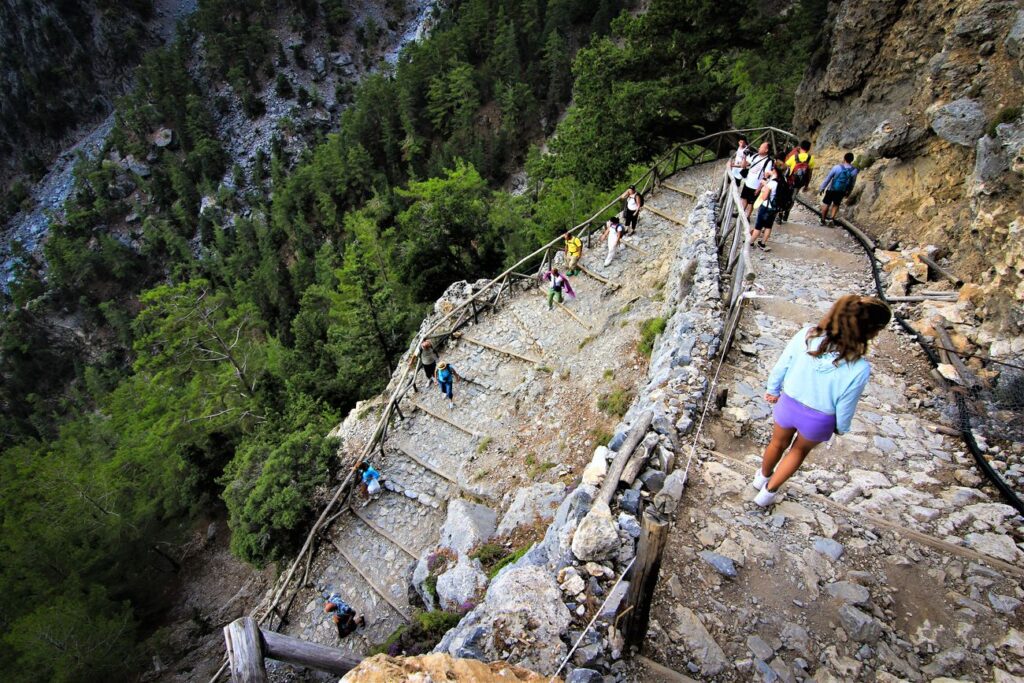
Start out at dawn to beat the heat and get ahead of the 1,000 or so like-minded folks who hike the gorge daily in high season (Samaria is the second-most visited site in Crete). It can be windy and cold atop the plateau, but be prepared with water and sunscreen, as the heat builds as you make the descent. Sturdy hiking shoes are essential as the path is stony and pitted with angular limestone outcrops and sinkholes. Unless you’re an experienced hiker, we recommend taking an organized tour. Read more on best trails in Greece
Best Foodie Experiences in Crete
Locally sourced ingredients, unfussy cooking and generations of culinary traditions help make Cretan cuisine the healthiest of all the Mediterranean diets. A vast coastline, largely untouched mountain ranges and fertile plains are the backdrop for Crete’s agricultural bounty, of which olive oil has played a central role stretching back 3,500 years.
With 35 million olive trees, Crete produces a third of all the olive oil in Greece, and 90 percent of it is extra virgin. Crete’s unique biodiversity includes myriad native wild herbs and greens. You will find traditional Greek appetizers, or meze, in Crete but usually with a Cretan twist.
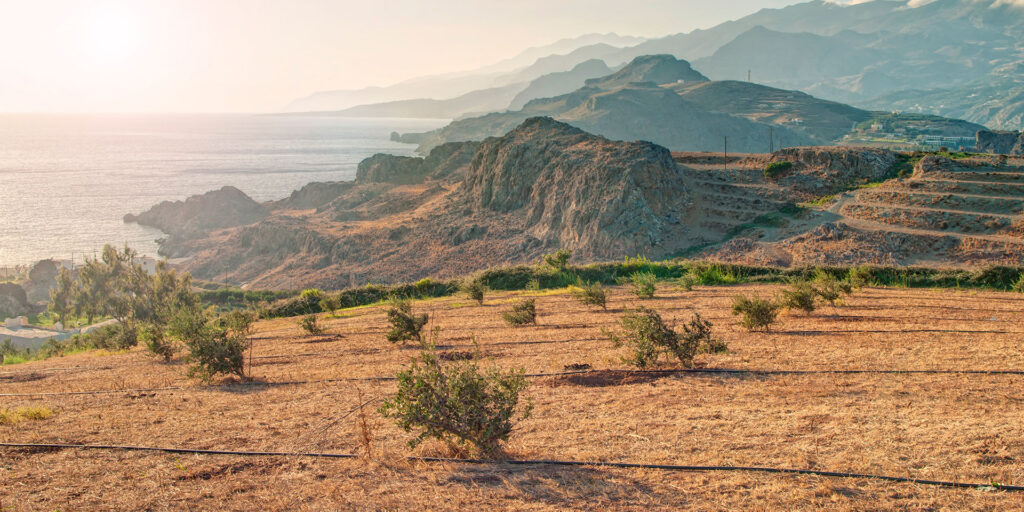
For example, there are the horta edible greens (lapatha, seskoula, kafkalithres, mironia, etc.), which not only make for some incredibly scrumptious “salty” pies (hortopitakia), but also, according to scientific studies, have an exceptionally high nutritional value, with plenty of micronutrients (i.e., vitamins and minerals).
What’s Cooking in Crete (and Where)
According to Stefanos Pertsemlidis, a leading Greek nutritionist, “The Cretan diet doesn’t differentiate much from the Greek/Mediterranean diet, as the term ‘Mediterranean diet’ is based on the Cretan diet of the early 1950s, when a very important study revealed the Cretan diet to be a protective factor against cancer and cardiovascular diseases.” He adds that what differentiates Cretan cooking from that of other areas of Greece is that “most of the other areas in Greece do not have the very wide variety of ingredients that Crete has. This is quite unique — especially for an island.”

Some 18 Cretan agricultural and livestock products and at least a dozen wines have been awarded PDO (Protected Designation of Origin) status. The foods of Crete are distinct from, yet form an integral part of, the entire delicious Greek gastronomic picture. “As in most areas of Greece, the Cretan diet has specific characteristics,” Pertsemlidis says, “such as the wedding food [gamopilafo, the wedding risotto] or the traditional antikristo [across the fire] method of cooking lamb and goat meat.” In Chania, one of the most popular destinations in Crete, home to many good restaurants with traditional Cretan menus. Try Ta Chalkina for the Cretan pork sausage, chicken souvlaki marinated in yogurt and garlic, and local snails in olive oil. For fish meze, the family-owned Portes (at Akti Papanikoli 1) wins plaudits, and for more excellent seafood, such as mussels in garlic and more, there’s Achilleas Fish Tavern (at Akti Papanikoli kai Monis Gonias). The Vritomartes Taverna (on Akit Olountos) is a popular spot, as is Nikos Fish Tavern (on Akti Virtomartis). But these are just a few suggestions; rest assured you’ll be able to try traditional dishes almost everywhere in Crete, whether along the coast or in the inland villages.
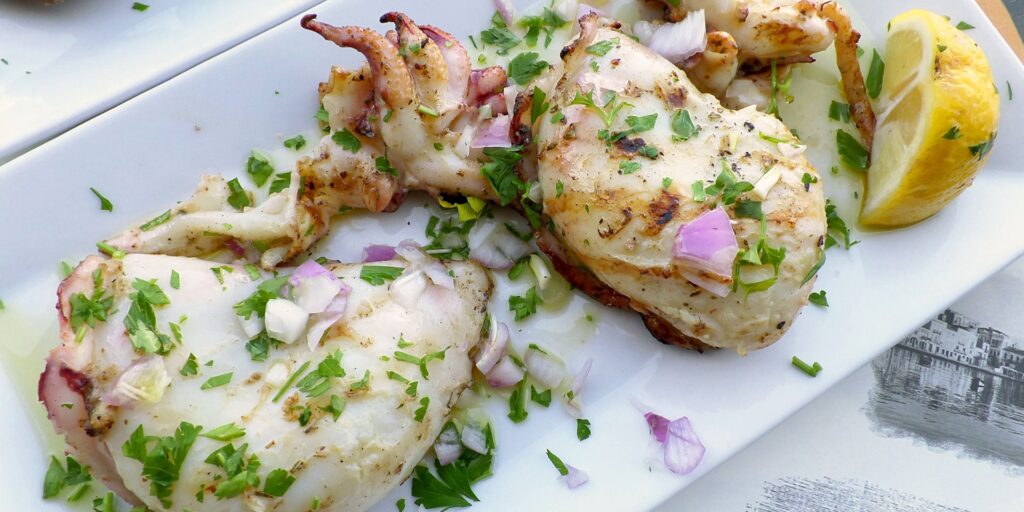
The climate of Crete lends itself to some fantastic local produce. The rich soil and long, sun-soaked seasons make for luscious fruit and vegetables and flavorful herbs. The bread and cheese are often made on the island, and your palate will certainly be able to tell. A visit to Crete will never be short on flavor. With such a glut of fabulous ingredients on the doorstep and a wonderful wine scene, it’s no wonder that Crete is blessed with a slew of lovely restaurants and foodie experiences.
Our Selection for Crete Cuisine
Palazzo Almare, Chania
With an atmospheric al fresco dining area overlooking Chania’s old harbor, Palazzo Almare is as popular for its position as it is for its food. The kitchen at this fine-dining waterside restaurant is loyal to Cretan tradition, only using high-quality, locally sourced ingredients for every dish. The Mediterranean menu majors in seafood caught in the surrounding waters, free-range local cattle and vegetables and herbs all grown nearby.
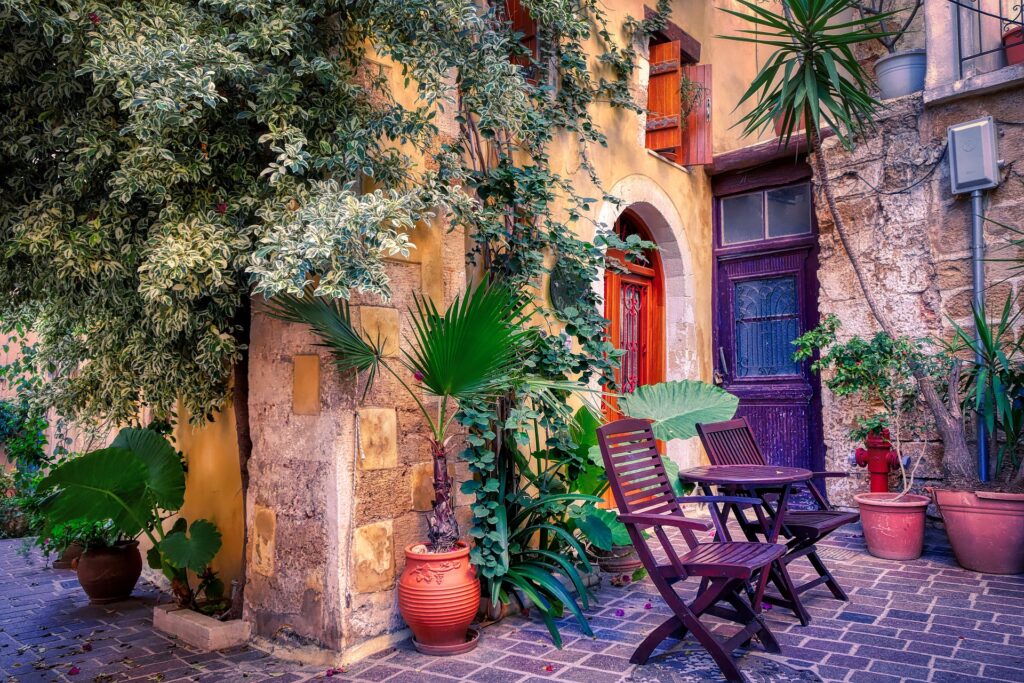
Olive Oil Experience, Kolymvari
Everyone knows Greek olive oil is the best in the world, but not everybody knows how it’s made. Now you can find out, at the oil-making HQ of Cretan brand Terra Creta. Guided tours walk you through every stage of the process, from harvesting to bottling, via the award-winning brand’s state-of-the-art olive oil mill. Tours conclude with tastings and the chance to stock up on travel-friendly bottles of your favourite varieties. You’ll find the Terra Creta base just 20 minutes’ drive from Chania in the seaside village of Kolymvari.
Manousakis Winery, Vatolakkos
To road-test some of Crete’s finest wine, head to the hills of Vatolakkos, where you’ll find the winery behind the award-winning Nostos brand. The Manousakis Winery has been producing 100 per cent organic wines in this serene Cretan village for two decades. Today, you can try a glass of Syrah or Grenache on the estate’s charming, tree-lined terrace, or sign up to a full-on wine tasting experience. They also offer tours of the old and new wineries, and jeep safaris out into the hilltop vineyards for a close-up look at the grapes.
Herb’s Garden, Heraklion
Herb’s Garden sells itself as a ‘balcony restaurant’, but that doesn’t really do its superb location justice. Part of the Lato Boutique Hotel, Herb’s Garden juts out from the building’s top floor offering panoramic views of Heraklion’s old city harbour and Venetian fortress through its glass walls. It opens late into the evening for diners to enjoy the sea breezes and twinkling lights of the harbour. And if you can draw your eyes from the view to the menu, you’ll find creative twists on Cretan and international dishes, traditional Greek coffee and homemade ice cream.
Avli, Rethymnon
Even if you’re not staying at the upmarket Avli hotel, a visit to its restaurant and cooking school is are a must. Housed in 16th-century Venetian buildings, this foodie destination blends Cretan cooking traditions old and new in creative dishes. Cooking classes are led by the hotel chef and focus on making healthy, tasty meals from just a handful of high-quality ingredients. The experience concludes with the class feasting on their creations.
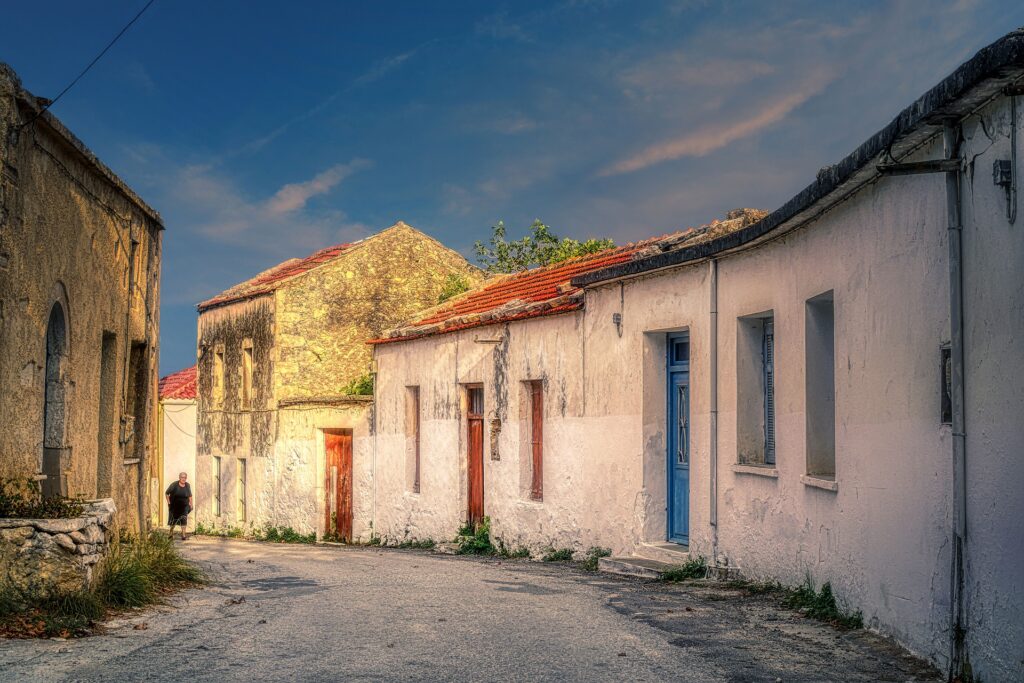
Ntounias, Drakona
Nestled on a slope in western Crete’s White Mountains, the rustic Ntounias taverna looks out onto scenic vistas of olive groves and mountain villages. This traditional family-run restaurant slow-cooks all of its dishes over wood fires and everything, from the vegetables to the olive oil, is either produced in the owner’s fields surrounding the restaurant or organically elsewhere in Crete. Even the meat comes from animals that roam the nearby slopes of Madara, so eating here is about as authentic a dining experience as you can get in Crete.
Lyrarakis Estate, Alagni
Don’t Leave Without Trying These Cretan Foods
Be sure to sweeten at least one of your meals with some Cretan honey, the product of bees collecting nectar from pine and acacia trees, as well as herbs like thyme, ironwort (Cretan mountain tea), oregano, sage and heather. Other edible Cretan wild herbs you’ll find flavoring your foods include dittany, sage and pennyroyal (squaw mint). Why not try some of Crete’s organic baby artichokes and askordoulakia (tassel hyacinth bulbs)? These are usually pickled in an olive oil, salt and vinegar mixture and sometimes served as meze to accompany raki (similar to ouzo). Kapriko is slow-roasted pork with a delectably crispy skin, while apaki and siglina are gourmet, smoke-cured cuts of pork.
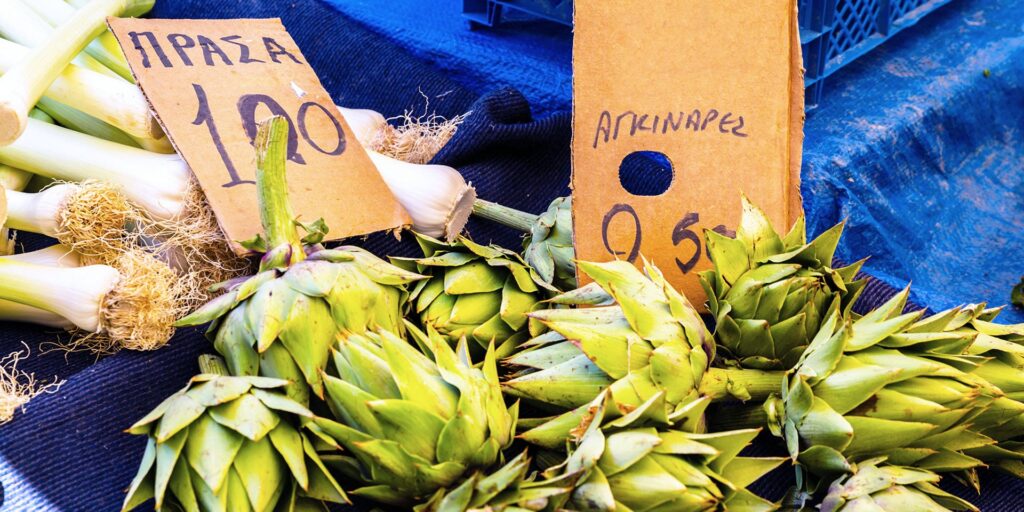
Skioufikta is a tube-shaped pasta cooked in a meat broth and topped with grated dry anthotyro cheese. At many Cretan tavernas, you can order xinohondros, a local pasta, often served with chopped tomatoes and soft farm cheese drizzled with extra-virgin olive oil. Zucchini flowers stuffed with rice and herbs are called anthi.The low-fat cheese spread called Xygalo is made from goat’s and/or sheep’s milk. Cretan cheeses often find their way into traditional pie recipes that can be sweet or savory (salted); you’ll see names for these like kaltsounia, mizithra, sfakianes, lichnarakia and others. Cretan graviera and three other cheeses have been awarded PDO designation. Read more on Greek Cheese

Dakos – A Fantastic Greek Bruschetta
The traditional hard Cretan bread rusks are made from barley and called dakos. Often they are served with chopped tomatoes on top, drizzled with soft cheese and sprinkled with olive oil. Snails, or hohli, are a much-treasured Cretan delicacy, and they are often fried with vinegar and rosemary (a dish called boubouristi). Read more on Greek breakfast. Cretans also like to nibble on dried figs, sultanas and currants. Carob is making a comeback, and Crete’s carob tree forests are the most extensive in the southeast Mediterranean.There are also organically grown fruits like oranges and grapes, as well as apples, from the Lassithi Plateau; sweet cherries from Gerakari; and even bananas from Arvi on the south coast. Kids love a local banana-flavored cola — called Zelita, it’s just one of the many fun foodie surprises you’ll find in Crete.
Related Readings


